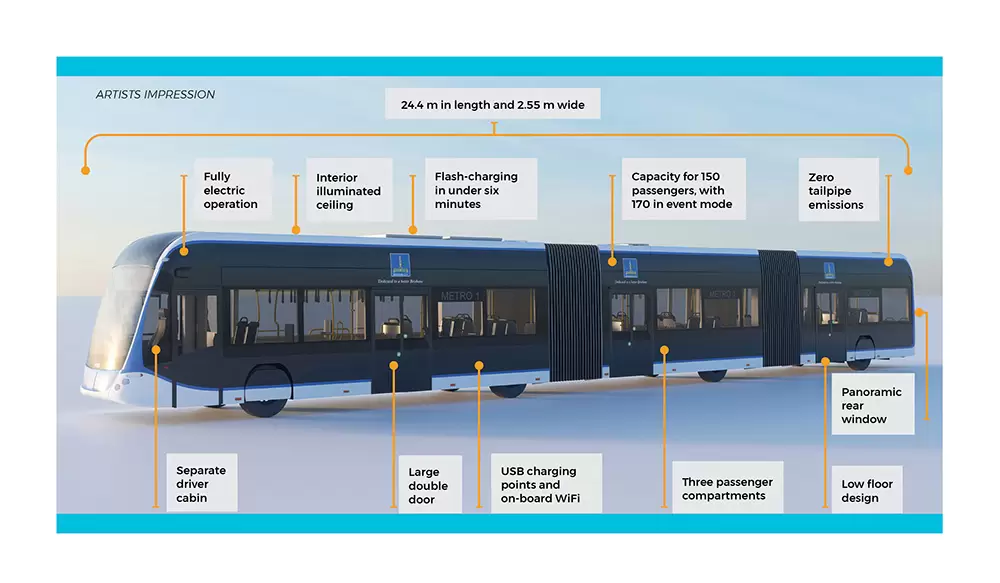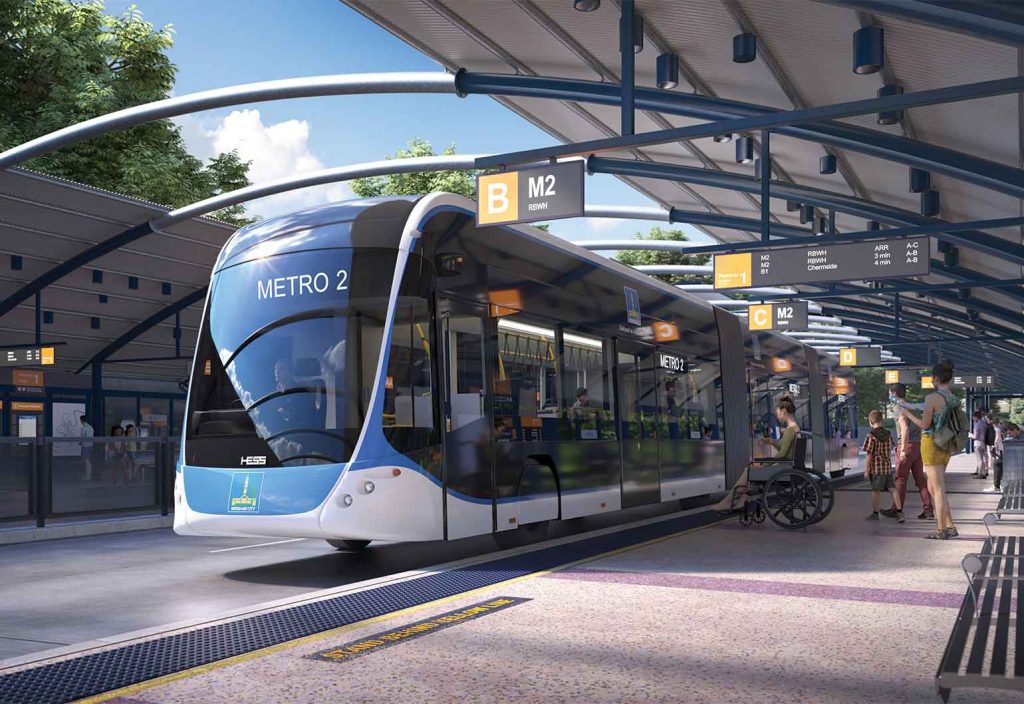Upgrading Brisbane’s system of busways has involved more than new vehicles or new lanes. The city’s metro project is an innovative solution.
When Brisbane was announced as the host for the 2032 Summer Olympic Games in July, it confirmed for the world what locals had long insisted: the city’s 20th-century reputation as a big country town was now long in its past.
With a booming population that has now surpassed 2.5 million, the Queensland capital is changing rapidly, and that change has brought with it new demands on the city’s infrastructure.
In response, Brisbane City Council announced in 2016 that it would introduce a new metro system to address constraints facing the city’s current bus network. Opening in 2023, the Brisbane Metro will consist of 18 stations connected across two lines over 21 km.
Stretching from Herston in the north to Eight Mile Plains in the south and extending west to the University of Queensland in St Lucia, the network will consist of 60 custom-designed vehicles that will run entirely off electricity and have zero tailpipe emissions.
But transforming a city’s transportation network also means solving some tricky engineering challenges, which is where Chartered engineer David Cox CPEng, Program and Commercial Manager, Major Projects, at Brisbane City Council comes in.

Getting Brisbane Metro ready to roll
A mechanical engineer and Queensland Chair of Engineers Australia’s Risk Engineering Society, Cox has an executive role on the Program Leadership Team for the $1.2 billion project.
“Brisbane Metro’s a transformational project in Brisbane City,” Cox said.
“The busway’s been operating for many years — since the early 2000s — and what Brisbane Metro seeks to do is upgrade the busway and introduce a new fleet of vehicles and some new operating modes to remove congestion and result in a better planned and better operating network.”
The project is not just designed to improve the busway, but to integrate into other components of the city’s transportation network, Cox said. This includes, for instance, the Cross River Rail project, due to open in 2024, which links the northern and southern sides of the city via a tunnel passing beneath the CBD and the Brisbane River.
“The two do work together to provide an improved transport network,” he explained.
“Cross River Rail is being delivered by the State Government; Brisbane Metro by Brisbane City Council.”
Originally, the plan was to convert the existing busway to light rail, but that soon shifted to something closer to a hybrid system: the new metro network would use “self-propelled rubber-tyred vehicles” rather than trams, but these would operate on a layout more like that of a light rail system.
“As the early feasibility studies progressed, it became obvious that [light rail] wasn’t going to provide value for money and there was probably a better way,” Cox said.
Each vehicle is 24.4 m long — more like a train carriage than an articulated bus, which measures about 18 m in length.
The contract to produce these was awarded to Swiss manufacturer Hess. Testing of the first vehicles will begin next year.
Quick as a flash
As well as operating without tailpipe emissions, Brisbane Metro’s vehicles have some other smart features — including the ability to recharge even while active on the network.
“This particular vehicle can operate 24/7 without needing to go back to the depot,” Cox said.
“Obviously you need to change drivers, you need to clean the vehicle and do a few things like that, but the flash charging … does provide the opportunity for continuous operation.”
That flash-charging system is the innovation that permits the buses to operate without interruption. Delivered by Hess partner Hitachi-ABB, it incorporates 15 fast-charging stations of 600 kW at end-of-trip points, as well as 60 slow-charging stations of 50 kW at the depot.
“What the vehicle will do is it will go into a charging bay, and a pantograph will deploy automatically,” Cox said.
“This only takes a few seconds, and then the vehicle will charge at 600 kW. It’s about a thousand amps, the current, so it’s a very fast charging process.”
The advantage of this network is that the vehicles are fully integrated into the system.
“It’s not just a vehicle on its own; it’s a vehicle that comes with a charging solution as well,” Cox said.
“Each vehicle will run from one end of the route to the other and it can recharge in under six minutes and then run back to the other end and do so again and again.
“So the idea there is you can have continuous operation of this vehicle; there’s no going back to the depot and plugging it in overnight.”
A Queensland concern
Although the system is based on existing technology used in Europe, the Brisbane Metro vehicles needed to be customised to ensure they suited the specific conditions of a Queensland city.
“It’s not just a matter of picking up a European design and plonking it down in Brisbane,” Cox said.
“There’s a lot of work that needs to be done, firstly around converting it to a left-hand drive vehicle to a right-hand drive design vehicle [and] ensuring that Australia’s design rules are complied with.”
Also significant were concerns about climate. While the vehicles in Europe are not air conditioned, that was not a practical option for a system operating in Brisbane — particularly in summer.
“Another key difference is the speed,” Cox mentioned.
“The vehicles in Europe are generally used in congested inner-city areas on a shared roadway and typically have a speed of 50 up to 60 km an hour. In Brisbane’s case, these vehicles will run on the dedicated busway and will be required to travel at speeds up to 90 km an hour.”
As a result, the team had to reassure regulators that the system was safe and stable at that speed.
“The electric motors and the propulsion system certainly have the capability to do that,” Cox said. “The actual performance of the vehicle and its ability to accelerate and reach top speed has never really been in doubt. It’s about how do we ensure that it dynamically performs in a safe manner at that speed.”
Although the vehicles themselves are innovative, the success of the network depends on its ability to integrate into the broader city.
“There’s an infrastructure component, there’s vehicles, there’s the systems, there’s the changing of the network in Brisbane City as well,” Cox said. “And there’ll be changes to policy and operations as well.
“It is a holistic solution.”
Accessibility matters
When it came to designing the vehicles to be used in the Brisbane Metro system, Cox wanted to ensure consideration was given to passengers with disabilities — and doing better than complying with minimum standards.
According to Brisbane City Council Public Transport Chair Ryan Murphy, the Brisbane Metro Accessibility Working Group was established in early 2019 to inform the design process.
“This engagement has covered key elements of the vehicle design, including the number and size of mobility-aided spaces,” Murphy said.
”This has been informed by several stages of engagement, including physically taping out the dimensions of the vehicle to test manoeuvrability of mobility with council commissioning the manufacture of a scale-sized timber mock-up of the front section of the vehicle.”
The team also used 3D design and virtual reality to ensure that the layout could accommodate passengers in wheelchairs.
“We’ve used accessibility groups to come in and test the practicality of the design and give feedback,” Cox said.
“It’s almost been a co-design process with some of those accessibility groups, and that’s actually made quite a few changes in the design process and delivered something that is different to what we originally anticipated.”
